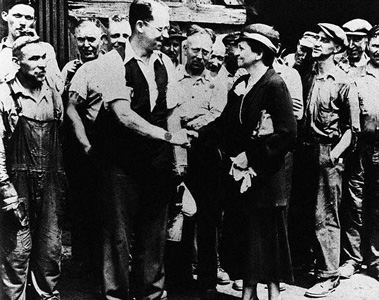
The appointment on March 4, 1933, by President Franklin D. Roosevelt made Perkins the first female cabinet member in U.S. history.
Legislation brought about under her administration included the National Labor Relations Act, the Fair Labor Standards Act, and the Social Security Act.
According to labor journalist Mark Gruenberg, what galvanized the original job safety movement, was the 1911 Triangle Fire in lower Manhattan. Frances Perkins was a social worker and witnessed the deaths at Triangle from across the street.
146 textile workers — all but a few of them young immigrant women — were trapped on the burning upper floors of the Asch Building, which housed their garment sweatshop, the Triangle Company.
The one fire escape ended above the ground and quickly became overloaded and collapsed. The doors were padlocked, supposedly to prevent “theft” by the workers. One worker escaped by sliding down the cable of the nonfunctioning elevator.
The fire department ladders weren’t tall enough to reach them. Hoses were of little use.
Others faced a gruesome choice: Burning to death or jumping. Most jumped.
Conditions at Triangle led to a whole host of pro-worker legislation, starting with fire safety codes. Triangle also drew attention to the plight of workers in general. That, in turn, influenced pro-worker legislation of the New Deal, pushed by Labor Secretary Perkins.
Students of labor history know that on Perkins’ watch, organized labor came into full legal rights but not without internal strife and potent backlash from anti-labor interests.
Glenda Holste’s review in Workday Minnesota of the biography of Perkins, “The Woman Behind the New Deal,” brings Frances Perkins into the historically accurate limelight of unparalleled progressive policy advances. Perkins, the book makes clear, figured out early as a suffrage proponent and activist in the settlement house movement that advocacy without legal clout could not generate sufficient social progress.
Kim Bobo’s book, “Wage Theft In America, Why millions of working Americans are not getting paid and what we can do about it, ” has a wonderful chapter about Frances Perkins. Bobo presents Perkins as “the most important Secretary of Labor in the Nation’s history.” and a model for what is needed now.
In reviewing the book for People’s World, Beatrice Lumpkin said: “The connection between Roosevelt and Perkins was very strong. Before she accepted appointment as President Roosevelt’s secretary of Labor, Perkins outlined her vision for overcoming the Great Depression. She proposed federal aid to pay unemployment relief, extensive public works projects to create jobs, laws for a minimum wage and maximum work week, abolition of child labor, old age pensions and a federal-state employment service. In short, she outlined a New Deal.”
Mrs. Lumpkin had the pleasure of meeting Perkins in 1938. Perkins was the featured speaker at a meeting of the American Labor Party on the West Side of New York. “The meeting was in a school classroom and I sat in the front seat of the middle row. Perkins set me on fire. I was 19 at the time. I think she noticed me, too, because in her next newsletter, she wrote about ‘the intense young woman who sat up front at the meeting.'”
The life and work of Frances Perkins continues to inspire today.
Photo: Frances Perkins she speaks with Carnegie Steel workers during the early years of the Roosevelt Administration. Frances Perkins Center Facebook page.

MOST POPULAR TODAY

High Court essentially bans demonstrations, freedom of assembly in Deep South

Zionist organizations leading campaign to stop ceasefire resolutions in D.C. area

UN warns that Israel is still blocking humanitarian aid to Gaza

U.S. imperialism’s ‘ironclad’ support for Israel increases fascist danger at home







Comments